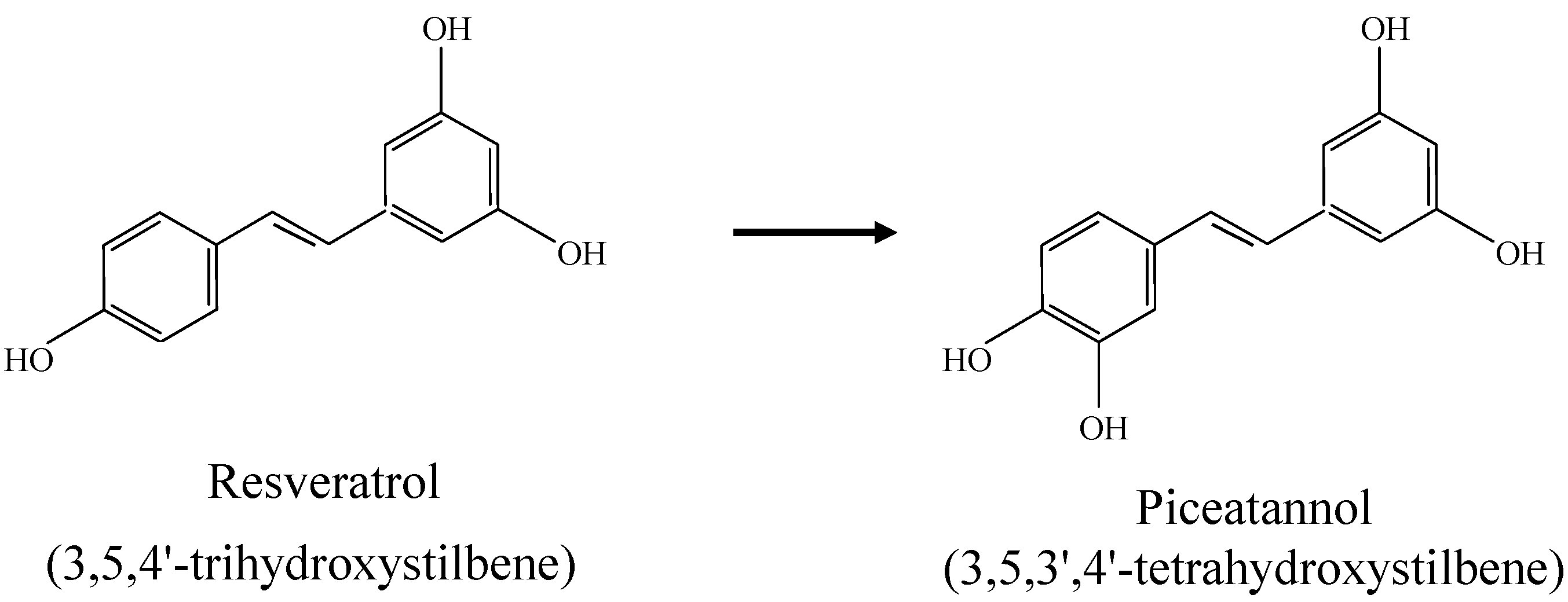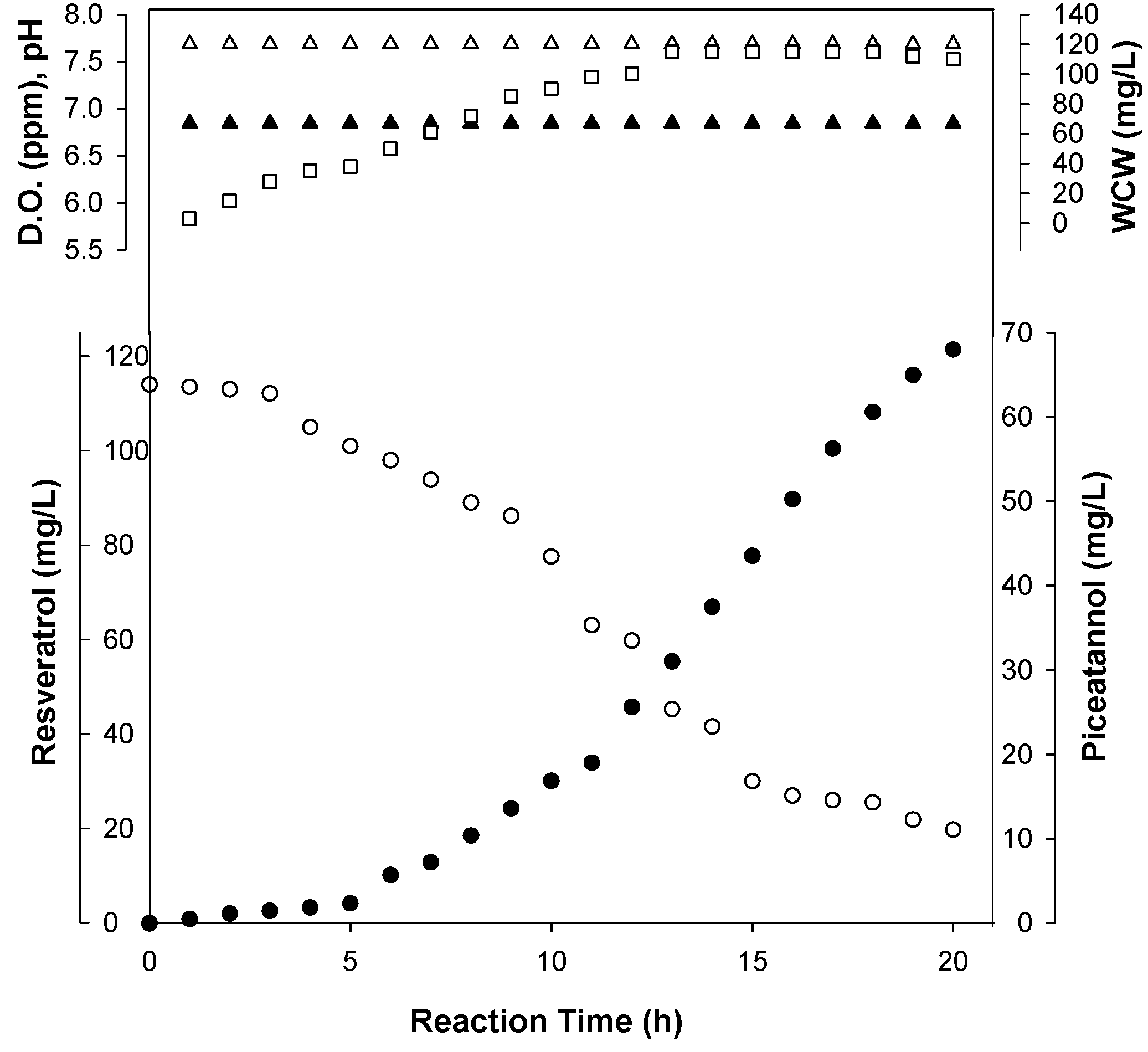Production of Anti-Cancer Agent Using Microbial Biotransformation
Abstract
:1. Introduction
2. Results and Discussion
2.1. Screening and Identification of the Microorganism for Regiospecific Hydroxylation of Resveratrol



2.2. Biotransformation for Production of Piceatannol
2.3. Anti-Cancer Activity Using Biotransformed Piceatannol


3. Experimental Section
3.1. Chemicals
3.2. Screening of Strain and Culture Conditions
3.3. Microbial Biotransformation
3.4. Gas Chromatography (GC)/Mass Spectrometry (MS) Analysis
3.5. Isolation of Product, Piceatannol
3.6. Anti-Cancer Activity Assay
4. Conclusions
Acknowledgments
Author Contributions
Conflicts of Interest
References
- Aggarwal, B.B.; Bhardwaj, A.; Aggarwal, R.S.; Seeram, N.P.; Shishodia, S.; Takada, Y. Role of resveratrol in prevention and therapy of cancer: Preclinical and clinical studies. Anticancer Res. 2004, 24, 2783–2840. [Google Scholar] [PubMed]
- Ogas, T.; Kondratyuk, T.P.; Pezzuto, J.M. Resveratrol analogs: Promising chemopreventive agents. Ann. N. Y. Acad. Sci. 2013, 1290, 21–29. [Google Scholar] [CrossRef] [PubMed]
- Pervaiz, S.; Holme, A.L. Resveratrol: Its biologic targets and functional activity. Antioxid. Redox Sign. 2009, 11, 2851–2897. [Google Scholar] [CrossRef]
- Baur, J.A.; Sinclair, D.A. Therapeutic potential of resveratrol: The in vivo evidence. Nat. Rev. Drug Discov. 2006, 5, 493–506. [Google Scholar] [CrossRef] [PubMed]
- Pearson, K.J.; Baur, J.A.; Lewis, K.N.; Peshkin, L.; Price, N.L.; Labinskyy, N.; Swindell, W.R.; Kamara, D.; Minor, R.K.; Perez, E.; et al. Resveratrol delays age-related deterioration and mimics transcriptional aspects of dietary restriction without extending life span. Cell Metab. 2008, 8, 157–168. [Google Scholar] [CrossRef] [PubMed]
- Piotrowska, H.; Kucinska, M.; Murias, M. Biological activity of piceatannol: Leaving the shadow of resveratrol. Mutat. Res. 2012, 750, 60–82. [Google Scholar] [CrossRef] [PubMed]
- Szekeres, T.; Saiko, P.; Fritzer-Szekeres, M.; Djavan, B.; Jager, W. Chemopreventive effects of resveratrol and resveratrol derivatives. Ann. N. Y. Acad. Sci. 2011, 1215, 89–95. [Google Scholar] [CrossRef] [PubMed]
- Zhang, H.; Jia, R.; Wang, C.; Hu, T.; Wang, F. Piceatannol promotes apoptosis via up-regulation of microRNA-129 expression in colorectal cancer cell lines. Biochem. Biophys. Res. Commun. 2014, 452, 775–781. [Google Scholar] [CrossRef] [PubMed]
- Camont, L.; Cottart, C.H.; Rhayem, Y.; Nivet-Antoine, V.; Djelidi, R.; Collin, F.; Beaudeux, J.L.; Bonnefont-Rousselot, D. Simple spectrophotometric assessment of the trans-/cis-resveratrol ratio in aqueous solutions. Anal. Chim. Acta 2009, 634, 121–128. [Google Scholar] [CrossRef] [PubMed]
- Roh, C. Biotransformation of isoflavone using enzymatic reactions. Molecules 2013, 6, 3028–3040. [Google Scholar] [CrossRef]
- Roh, C.; Seo, S.H.; Choi, K.Y.; Cha, M.; Pandey, B.P.; Kim, J.H.; Park, J.S.; Kim, D.H.; Chang, I.S.; Kim, B.G. Regioselective hydroxylation of isoflavones by Streptomyces avermitilis MA-4680. J. Biosci. Bioeng. 2009, 108, 41–46. [Google Scholar] [CrossRef] [PubMed]
- Kim, M.K.; Im, W.T.; Ohta, H.; Lee, M.; Lee, S.T. Sphingopyxis granuli sp. nov., a β-glucosidase-producing bacterium in the family Sphingomonadaceae in α-4 subclass of the Proteobacteria. J. Microbiol. 2005, 43, 152–157. [Google Scholar] [PubMed]
- Hall, T.A. BioEdit: A User-Friendly Biological Sequence Alignment Editor and Analysis Program for Windows 95/98/NT; Nucleic Acids Symposium Series 41; Oxford University Press: Oxford, UK, 1999; pp. 95–98. [Google Scholar]
- Thompson, J.D.; Gibson, T.J.; Plewniak, F.; Jeanmougin, F.; Higgins, D.G. The CLUSTAL_X windows interface: Flexible strategies for multiple sequence alignment aided by quality analysis tools. Nucleic Acids Res. 1997, 25, 4876–4882. [Google Scholar] [CrossRef] [PubMed]
- Kimura, M. The Neutral Theory of Molecular Evolution; Cambridge University Press: Cambridge, UK, 1983. [Google Scholar]
- Saitou, N.; Nei, M. The neighbor-joining method: A new method for reconstructing phylogenetic trees. Mol. Biol. Evol. 1987, 4, 406–425. [Google Scholar] [PubMed]
- Fitch, W.M. Toward defining the course of evolution: Minimum change for a specific tree topology. Syst. Biol. 1971, 20, 406–416. [Google Scholar] [CrossRef]
- Kumar, S.; Tamura, K.; Nei, M. MEGA3: Integrated software for molecular evolutionary genetics analysis and sequence alignment. Brief. Bioinform. 2004, 5, 150–163. [Google Scholar] [CrossRef] [PubMed]
- Lee, N.; Kim, E.; Kim, B. Regioselective hydroxylation of trans-resveratrol via inhibition of tyrosinase from Streptomyces avermitilis MA4680. ACS Chem. Biol. 2012, 7, 1687–1692. [Google Scholar] [CrossRef] [PubMed]
- Furuya, T.; Kino, K. Regioselective synthesis of piceatannol from resveratrol: Catalysis by two-component flavin-dependent monooxygenase HpaBC in whole cells. Tetrahedron Lett. 2014, 55, 2853–2855. [Google Scholar] [CrossRef]
- Sample Availability: Samples of the compounds used in this study are available from the authors.
© 2014 by the authors. Licensee MDPI, Basel, Switzerland. This article is an open access article distributed under the terms and conditions of the Creative Commons Attribution license ( http://creativecommons.org/licenses/by/4.0/).
Share and Cite
Roh, C.; Kang, C. Production of Anti-Cancer Agent Using Microbial Biotransformation. Molecules 2014, 19, 16684-16692. https://doi.org/10.3390/molecules191016684
Roh C, Kang C. Production of Anti-Cancer Agent Using Microbial Biotransformation. Molecules. 2014; 19(10):16684-16692. https://doi.org/10.3390/molecules191016684
Chicago/Turabian StyleRoh, Changhyun, and ChanKyu Kang. 2014. "Production of Anti-Cancer Agent Using Microbial Biotransformation" Molecules 19, no. 10: 16684-16692. https://doi.org/10.3390/molecules191016684
APA StyleRoh, C., & Kang, C. (2014). Production of Anti-Cancer Agent Using Microbial Biotransformation. Molecules, 19(10), 16684-16692. https://doi.org/10.3390/molecules191016684





